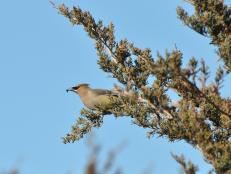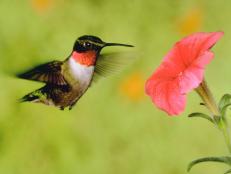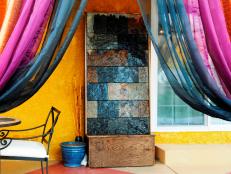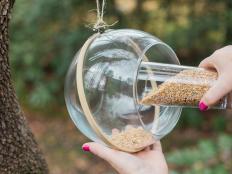How to Use Water Features to Attract Birds to Your Yard
See how a rocket engineer attracts birds by setting up proper habitats that include the gurgling sound of moving water.
Water is a key element to attracting birds, and creatively designed water features are not only pleasing to our senses, but they are appealing to the birds' senses as well. The sounds and sights of moving water — dripping, gurgling, bubbling, flowing and splashing — attracts birds to drop down from their migratory flyways to layover, refuel, drink and bathe.

Birds, rabbits, fox, raccoons and opossums have been observed visiting the bubbling rock water feature in the "outback garden" as well as a screech owl that shows up three times a week to bathe and drink. The wildlife activity is documented by a motion-sensor security camera at night and by the homeowner during the day.
Herb Lewis, a retired engineer, whose career encompassed test of the Saturn V Moon Rocket and ballistic missile defense, epitomizes the rocket-science way of life in Huntsville, Alabama, and his garden shows an industrial engineer’s attention to detail and precision. Herb takes an analytical approach with an empathetic thought process in the creation of forest edges, open fields, corridors and dense thickets in his backyard bird habitat. Each zone is meticulously designed for a bird’s needs — food, water and places to hide and nest. Living in close proximity to a state park, nature preserves, mountains and rivers, Herb takes advantage of the neighboring natural spaces by extending the wild into his suburban yard.

Herb Lewis
A tabletop water feature placed on the deck provides opportunities for up-close viewing and photographing visiting birds. This northern flicker doesn't seem to mind sharing the watering hole with a couple of robins.
When Herb retired from the defense industry, he combined his love of gardening and birds. His wife, Terry, certified their yard as a Wildlife Habitat with the National Wildlife Federation (NWF), and his perspective for a longtime hobby changed. He began to apply techniques and methods presented by the NWF, and a most important component for a habitat garden is water.

Herb Lewis
A pedestal birdbath is the simplest way to offer water to the birds and can be installed anywhere in the garden but better to nestle the pedestal among vegetation.
Considering the yard as a landing strip for birds, Herb works to reduce lawn and build microenvironments that include all of the habitat essentials. Tucked away in the garden, and in the "outback" lot abutting their yard, are six water features. A drip column, reflection pool, pedestal birdbath, a small tabletop water feature, a large bubbling rock system and a waterfall are all strategically placed throughout the yard. Each one is surrounded by dense plantings to offer protective corridors and pathways for the birds to approach in safety. Each water feature is thoughtfully placed among the habitats.

Herb Lewis
A drip-rock column is tucked away behind shrubbery and ferns and only offers sips of water.
The large bubbling-rock water feature sits in a meadow-like setting but close enough to large trees, and Herb added more plants to the perimeter of the feature. “Birds are vulnerable out in the open,” Herb explains, “but if a water feature is placed amongst trees and shrubs, then there will be places for birds to escape to when they feel threatened. Also, plants give structure for birds to preen and sun themselves after bathing in the bubbling rock.” Besides creating safety and security for the birds, Herb also provides natural food sources by planting seed-bearing and nectar plants.
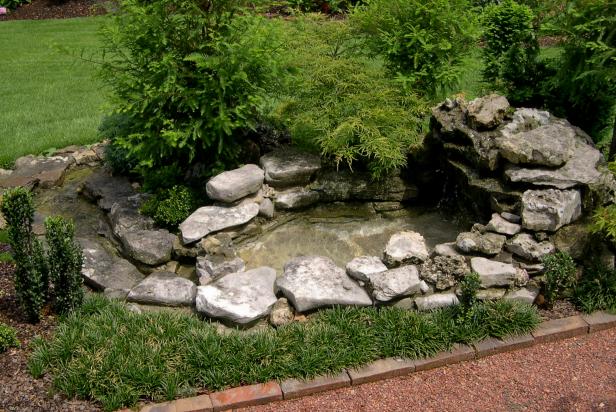
Herb Lewis
Herb and Terry have a bird’s eye view of the waterfall feature. The bubbling water attracts many thirsty visitors including neo-tropical migrating birds. Water movement is also important to keep mosquitoes out. A heater keeps the water from freezing during the winter.
“Planning is important,” Herb says. “You’ll need to run electricity for water pumps and aerators, so take these things into account when you are figuring out where to put them.” The solar fountains are not suitable if you want to attract birds to the water features. The solar panels take up too much surface and may scare off the birds. A water feature, whether small or large, a simple basin or complex system, needs to be installed properly. Prepare and plan ahead of the project, and consider all of the components — liners and underlining materials, reservoirs, circulating pumps, aerators and agitators. Make them look more natural and inviting by adding rocks, wood and plants. “A shallow depth of an inch is best,” Herb says, “or if it is deeper, make it sloped or graded so the birds can go in as deep as they want. They need to be able to see the bottom and feel safe from predators.” The bubbling rock feature in the “outback garden” is 12-feet in diameter and has a buried 35-gallon reservoir. The feature is filled with rock, the big bubbling rock is set in on top of them and pea gravel is used as a filter. Herb moved the rocks around to expose the water table and create a pool. A small waterfall circulates water, a pool amplifies the babbling sound of water and rocks and pebbles are arranged to create two shallow bathing pools.

Herb Lewis
Common grackles in the eastern US have an iridescent purple appearance. These blackbirds with golden eyes are fun to watch as they forage in flocks.
Herb publishes his observations, thoughts and ideas, and portraits of the visiting birds on his website Creative Birding.
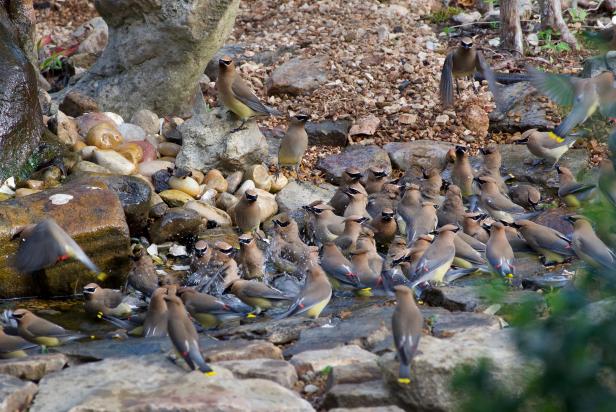
Herb Lewis
Cedar waxwings roost, nest and travel together in large flocks. Always on the move looking for berries, they will make frequent stops wherever water and fruit are available.






